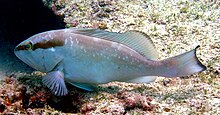Red grouper
| Red grouper | |
|---|---|

| |
| Scientific classification | |
| Domain: | Eukaryota |
| Kingdom: | Animalia |
| Phylum: | Chordata |
| Class: | Actinopterygii |
| Order: | Perciformes |
| Family: | Serranidae |
| Subfamily: | Epinephelinae |
| Genus: | Epinephelus |
| Species: | E. morio
|
| Binomial name | |
| Epinephelus morio (Valenciennes, 1828)
| |
| Synonyms[2] | |
| |
The red grouper (Epinephelus morio) is a species of marine
and sea basses. It is found in the western Atlantic Ocean.Description
The red grouper has a body with a
Distribution
The red grouper's typical range is coastal areas in the western Atlantic, stretching from southern Brazil to North Carolina in the US and including the Gulf of Mexico and Bermuda.[2]
Habitat and biology
The red grouper is a demersal, largely sedentary species which has an extended (~40 day) pelagic larval stage before it settles in shallow coastal hardbottom habitat as juveniles. They remain in inshore waters for 4–5 years before migrating to offshore hardbottom habitat—particularly on the edge of the continental self—as adults. Spawning occurs offshore between January and June, peaking in May. While primarily eating benthic invertebrates, the red grouper is an opportunistic feeder in the reef community. The diet commonly includes xanthid and portunid crabs, juvenile spiny lobster, and snapping shrimp, with the occasional fish. The red grouper is of moderate size, about 125 cm and weighs 23 kg or more. Body coloration is typically reddish-brown in color often, with many white spots. When aggravated (they are highly territorial) or involved in spawning activities, these fish can very rapidly change coloration patterns, with the head or other parts of the body turning completely white, and the white spots appearing more intense.

Habitat engineers of the sea
Red grouper actively excavate pits in the seafloor. They start digging in the sediment from the time they settle out of the plankton and continue throughout their lifetime. They use their caudal fin and their mouths to remove debris and sediment from rocks, creating exposed surfaces on which sessile organisms actively settle (e.g., sponges, soft corals, algae). The exposure of structure also attracts a myriad of other species, including mobile invertebrates and a remarkable diversity of other fishes, from gobies and butterflyfish to grunts and snapper. The
Parasites
As other fish, red groupers harbour a number of
.Taxonomy
The red grouper was first formally
Utilisation
The red grouper is a commercially important species for fisheries throughout its range and it is also an valuable resource for recreational fisheries too.[4]

References
- . Retrieved 15 November 2021.
- ^ a b c d Froese, Rainer; Pauly, Daniel (eds.) (2019). "Epiphenelus morio" in FishBase. December 2019 version.
- ^ ISBN 92-5-103125-8.
- ^ a b c "Epinephelus morio Valenciennes, 1828". Indian River Lagoon Species Inventory. Smithsonian Marine Station at Fort Pierce. Retrieved 11 July 2020.
- ^ "Epinephelus morio". Discover Fishes. Florida Museum. 12 May 2017. Retrieved 11 July 2020.
- PMID 9437838.

- ^ Eschmeyer, William N.; Fricke, Ron & van der Laan, Richard (eds.). "Serranus morio". Catalog of Fishes. California Academy of Sciences. Retrieved 11 July 2020.
External links
- Photos of Red grouper on Sealife Collection

